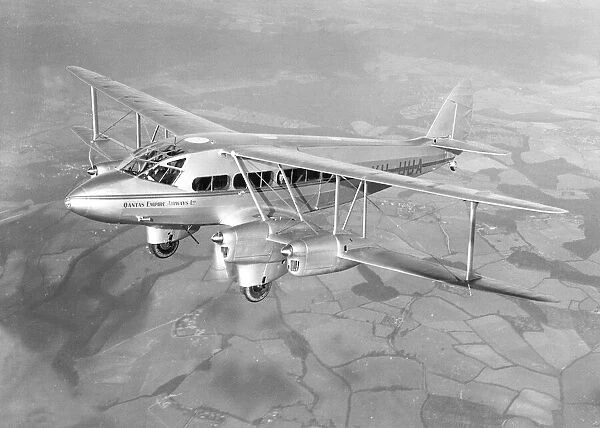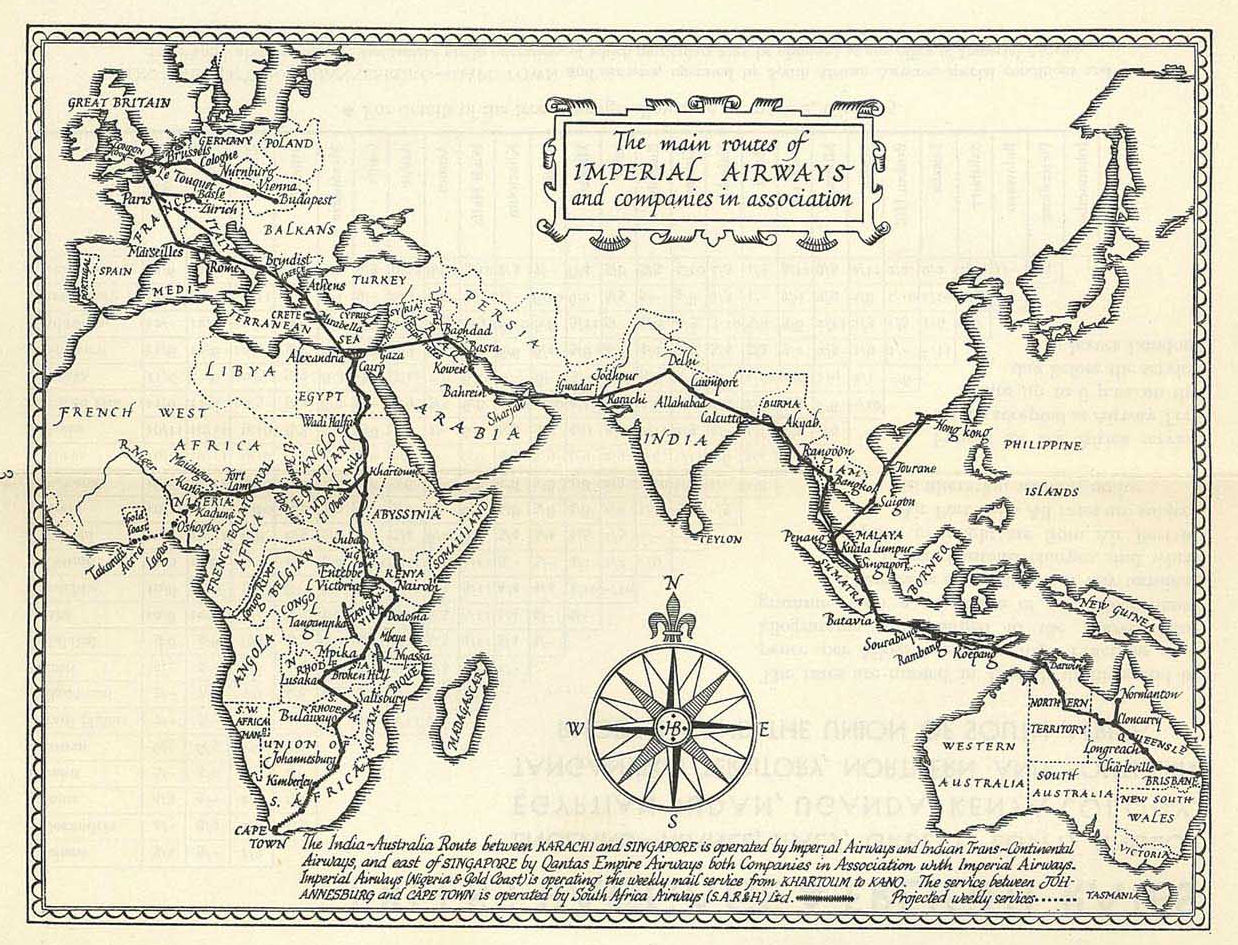Australia first saw a foreign airliner in 1933, when Imperial Airways operated an Armstrong Whitworth Atalanta survey flight from Croydon through Asia to Darwin and following the inland route to Brisbane, Sydney, Canberra and Melbourne. Scheduled international service began in 1935, when Qantas used DH-86 biplanes between Brisbane and Singapore on a four-day multi-stop route, flying only in the daytime, with passengers spending the nights at hotels en route. The service connected with Imperial Airways flights on to London.

Qantas deHavilland DH-86 c.1935
More modern-looking airliners had been seen in Australia in 1934, when the Dutch airline KLM entered an American DC-2 in the London to Melbourne Air Race, which finished second to a specially-built racing plane. A Boeing 247 finished third: both were all-metal twin-engined low-wing monoplanes.
DeHavilland DH-86 biplanes were used for Qantas’ four-day journey from Brisbane to Singapore to connect with Imperial Airways service to London. This had been replaced by 1938 with a thrice-weekly service with Short Empire flying-boats through from Rose Bay, Sydney to Southampton Water, England, mainly flown by day with night stops at hotels, some specially built for the service. Qantas’ owned some of the aircraft but all were crewed by Qantas between Australia and Singapore, and by Imperial between Singapore and Britain.

Imperial Airways timetable March 1936
Reading from the October 1938 timetable, flights left Sydney on Tuesday, Thursday and Saturday at 7am, stopped at Brisbane and Gladstone before the first night-stop at Townsville. The second day the stops were at Karumba and Groot Eylandt before the night at Darwin, Then stops at Koepang and Bima before the night stop at Surabaya, followed by Batavia, Klabat Bay, and Singapore en route to the night stop at Penang. Imperial Airways crew would take over from Qantas at Singapore. The fifth day’s stops were two in Siam, now Thailand, Koh Samui and Bangkok, two in Burma, Rangoon and Akyab, and the night stop was at Calcutta, Then Allahabad, Gwalior, and Raj Samand en route to the Karachi night-stop. The seventh day stops were made at Jiunri in Baluchistan, Dubai, then in Oman, and Bahrain before the night stop at Basra in Iraq. Habbaniyeh (Iraq) and Lake Tiberias (Palestine) were the stops before the night stop at Alexandria (Egypt). Mirabella in Crete, Athens and Brindisi were the stops en route to the night-stop at Rome. The last day’s journey was via Marseilles and St Nazaire in France before terminating at Southampton Water at 3.25pm on the tenth day. Passengers were taken by train to Imperial Airways terminal at Victoria. The return journey to Sydney was similar, leaving Southampton at 5.30am (after a train from London the previous evening and a nigh-stop) and making the same 35 stops, including 9 night-stops and rreaching Sydney at 4.15pm on the tenth day.
By 1938, the Dutch airline KLM and its East Indian subsidiary were operating landplanes from Batavia (now Jakarta) to Sydney as an extension to their route from Amsterdam, and Carpenter’s, the New Guinea trading company, had started a regular landplane passenger service between Australia and Port Moresby and Lae.
All of these services ceased with the outbreak of war. When Italy entered the war the European services terminated in the Middle East, and Japan’s attacks from 1941 meant the closure of the routes to Singapore and New Guinea. By this time. Imperial Airways had been merged into BOAC.
The only Australian route operating throughout the war was the Tasman Empire Airways Empire Short Empire boats to Auckland, which had started in 1940. Pan American from the USA had been denied Australian rights, but commenced flying to New Zealand with Boeing 314 flying-boats in 1940. Their last flight was in Auckland when Pearl Harbor was attacked and the aircraft became the first commercial plane to fly round the world by flying on through Australia, India, and Africa to New York.
Under war conditions, Qantas developed a route for use by priority passengers and mail, between Perth and Ceylon. Cocos Island, although never occupied by Japan, would have been a logical stopping point, was too vulnerable to Japanese raids to be usable. The direct route was flown in radio silence and without radio navigation aid by Catalina flying-boats, which while slow had a long range: the flights were airborne for 27 to 33 hours. and could only carry on average three passengers and vital mail. The Catalinas operated from July 1943, and were supplemented from June 1944 by Liberator landplanes with greater speed and capacity until 1945.
Qantas’ Ceylon route was then replaced with a through service from Sydney to England with BOAC Lancastrians (converted bombers, like the Liberators) initially via Learmonth. Western Australia and Colombo. This service was flown by night and day, and the flight from Sydney to Hurn in England must have been an exhausting experience: there were nine seats, facing sideways, in a noisy, unpressurised aircraft with extremely limited facilities and the trip lasted three and a half days.
Because Malaya, Singapore and the Dutch East Indies were not liberated from the Japanese occupation until 12th September 1945, the traditional route through Darwin and Singapore was not used initially. By May 1946: the Lancastrians were supplemented by a slower flying-boat service with converted Shorts Sandringhams, in daytime with six night stops. Qantas did not operate its own aircraft through to London until it was allowed to buy the advanced Lockheed Constellations, pressurised and much faster aircraft, and inaugurated London services in December 1947.

Qantas Lockheed Constellation c.1948
Initially, three night stops were included in each direction, but these were gradually reduced as the frequency increased: by 1953 both BOAC and Qantas were operating three Constellations weekly with two night stops, and the following year Qantas introduced the larger Super Constellations, the night stops were reduced to one, and Tourist class was available on some flights. Flights became daily soon afterwards, and the route varied with time to add more European and Asian points on different days of the week. A typical 1954 Super Constellation schedule left Sydney on Monday at 9:30pm, arriving for the night-stop in Singapore at 3:10pm after stopping at Darwin and Jakarta: After leaving Singapore at 7:30am Wednesday, and making stops at Bangkok, Calcutta, Karachi, Beirut, Rome and Frankfurt it was due to land at London Airport at 3:05pm on the Thursday.
BOAC waited for the arrival of the turbo-prop Britannia to replace Constellations, and eliminated the en-route night stop. This was the fastest service prior to the introduction of jet aircraft: by 1957 the Tuesday service leaving Sydney at 9pm reached London at 2:05pm Thursday after seven en-route stops.
Robin Johnson